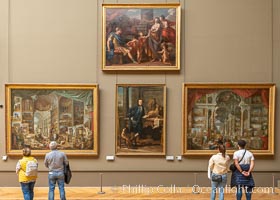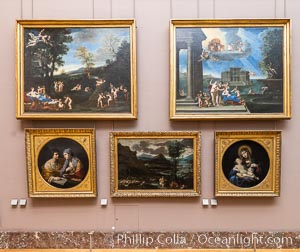
The Expulsion of Heliodorus from the Temple, Raphael, Musee du Louvre.
Location: Musee du Louvre, Paris, France
Image ID: 35705
Location: Musee du Louvre, Paris, France
Image ID: 35705

Venus as Huntress Appears to Aeneas, Cortona, Musee du Louvre.
Location: Musee du Louvre, Paris, France
Image ID: 35708
Location: Musee du Louvre, Paris, France
Image ID: 35708
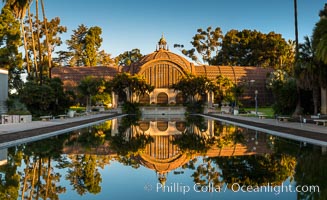
The Botanical Building in Balboa Park, San Diego. The Botanical Building, at 250 feet long by 75 feet wide and 60 feet tall, was the largest wood lath structure in the world when it was built in 1915 for the Panama-California Exposition. The Botanical Building, located on the Prado, west of the Museum of Art, contains about 2,100 permanent tropical plants along with changing seasonal flowers. The Lily Pond, just south of the Botanical Building, is an eloquent example of the use of reflecting pools to enhance architecture. The 193' by 43' foot pond and smaller companion pool were originally referred to as Las Lagunas de las Flores (The Lakes of the Flowers) and were designed as aquatic gardens. The pools contain exotic water lilies and lotus which bloom spring through fall.
Location: Balboa Park, San Diego, California
Image ID: 28824
Panorama dimensions: 6045 x 9876
Location: Balboa Park, San Diego, California
Image ID: 28824
Panorama dimensions: 6045 x 9876

The Botanical Building in Balboa Park, San Diego. The Botanical Building, at 250 feet long by 75 feet wide and 60 feet tall, was the largest wood lath structure in the world when it was built in 1915 for the Panama-California Exposition. The Botanical Building, located on the Prado, west of the Museum of Art, contains about 2,100 permanent tropical plants along with changing seasonal flowers. The Lily Pond, just south of the Botanical Building, is an eloquent example of the use of reflecting pools to enhance architecture. The 193' by 43' foot pond and smaller companion pool were originally referred to as Las Lagunas de las Flores (The Lakes of the Flowers) and were designed as aquatic gardens. The pools contain exotic water lilies and lotus which bloom spring through fall.
Location: Balboa Park, San Diego, California
Image ID: 28825
Panorama dimensions: 6838 x 12347
Location: Balboa Park, San Diego, California
Image ID: 28825
Panorama dimensions: 6838 x 12347

The Botanical Building in Balboa Park, San Diego. The Botanical Building, at 250 feet long by 75 feet wide and 60 feet tall, was the largest wood lath structure in the world when it was built in 1915 for the Panama-California Exposition. The Botanical Building, located on the Prado, west of the Museum of Art, contains about 2,100 permanent tropical plants along with changing seasonal flowers. The Lily Pond, just south of the Botanical Building, is an eloquent example of the use of reflecting pools to enhance architecture. The 193' by 43' foot pond and smaller companion pool were originally referred to as Las Lagunas de las Flores (The Lakes of the Flowers) and were designed as aquatic gardens. The pools contain exotic water lilies and lotus which bloom spring through fall.
Location: Balboa Park, San Diego, California
Image ID: 28826
Panorama dimensions: 5475 x 11746
Location: Balboa Park, San Diego, California
Image ID: 28826
Panorama dimensions: 5475 x 11746

Stained glass in entrance hall, Rijksmuseum, Amsterdam.
Location: Rijksmuseum, Amsterdam, Holland, Netherlands
Image ID: 29449
Location: Rijksmuseum, Amsterdam, Holland, Netherlands
Image ID: 29449
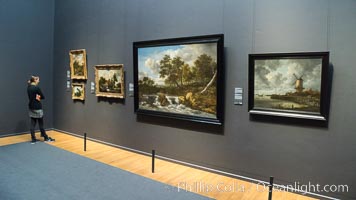
Rijksmuseum gallery and visitor, Amsterdam.
Location: Rijksmuseum, Amsterdam, Holland, Netherlands
Image ID: 29450
Location: Rijksmuseum, Amsterdam, Holland, Netherlands
Image ID: 29450

'The Conspiracy of the Batavians under Claudius Civilis' (1661-62), Rembrandt van Rijn.
Location: Rijksmuseum, Amsterdam, Holland, Netherlands
Image ID: 29451
Location: Rijksmuseum, Amsterdam, Holland, Netherlands
Image ID: 29451

Militiamen of the Company of Captain Roelof Bicker and Lieutenant Jan Michielsz. Blaeuw (Officers and other Marksmen of the VIII District in Amsterdam before the De Haan Brewery at the Corner of the Lastaadje), Bartholomeus van der Helst, 1639.
Location: Rijksmuseum, Amsterdam, Holland, Netherlands
Image ID: 29452
Location: Rijksmuseum, Amsterdam, Holland, Netherlands
Image ID: 29452

The Battle of Terheide, Jan Abrahamsz. Beerstraten, 1653 - 1666. Oil on canvas, h 176cm x w 281.5cm.
Location: Rijksmuseum, Amsterdam, Holland, Netherlands
Image ID: 29453
Location: Rijksmuseum, Amsterdam, Holland, Netherlands
Image ID: 29453
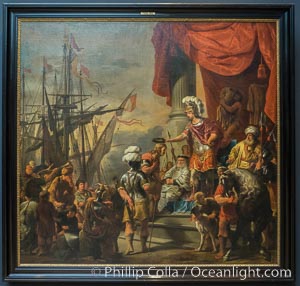
Aeneas at the Court of Latinus, Ferdinand Bol, c. 1661 - c. 1664, canvas, h 218cm x w 232cm.
Location: Rijksmuseum, Amsterdam, Holland, Netherlands
Image ID: 29454
Location: Rijksmuseum, Amsterdam, Holland, Netherlands
Image ID: 29454
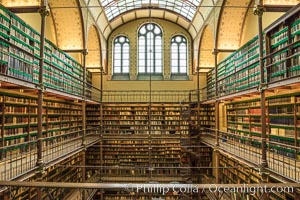
The Rijksmuseum Research Library, Amsterdam.
Location: Rijksmuseum, Amsterdam, Holland, Netherlands
Image ID: 29455
Location: Rijksmuseum, Amsterdam, Holland, Netherlands
Image ID: 29455

The Home Fleet Saluting the State Barge, Jan van de Cappelle, 1650, oil on panel, h 64cm x w 92.5cm.
Location: Rijksmuseum, Amsterdam, Holland, Netherlands
Image ID: 29456
Location: Rijksmuseum, Amsterdam, Holland, Netherlands
Image ID: 29456

Stained glass in entrance hall, Rijksmuseum, Amsterdam.
Location: Rijksmuseum, Amsterdam, Holland, Netherlands
Image ID: 29457
Location: Rijksmuseum, Amsterdam, Holland, Netherlands
Image ID: 29457

Peasant Kermis, David Teniers (II), c. 1665, canvas, h 78cm x w 106.5cm.
Location: Rijksmuseum, Amsterdam, Holland, Netherlands
Image ID: 29458
Location: Rijksmuseum, Amsterdam, Holland, Netherlands
Image ID: 29458

The Finding of Moses, Moyses van Wtenbrouck, c. 1625 - c. 1627, oil on panel, h 73.5cm x w 99.5cm.
Location: Rijksmuseum, Amsterdam, Holland, Netherlands
Image ID: 29459
Location: Rijksmuseum, Amsterdam, Holland, Netherlands
Image ID: 29459

View of Olinda, Brazil, Frans Jansz Post, 1662, oil on canvas, h 107.5cm x w 172.5cm.
Location: Rijksmuseum, Amsterdam, Holland, Netherlands
Image ID: 29460
Location: Rijksmuseum, Amsterdam, Holland, Netherlands
Image ID: 29460

The Dutch Ambassador on his Way to Isfahan, Jan Baptist Weenix, 1653 - 1659, canvas, h 101cm x w 179cm x w 24.5kg.
Location: Rijksmuseum, Amsterdam, Holland, Netherlands
Image ID: 29461
Location: Rijksmuseum, Amsterdam, Holland, Netherlands
Image ID: 29461

The Return to Amsterdam of the Second Expedition to the East Indies, Hendrik Cornelisz. Vroom, 1599. Oil on canvas, h 102.3cm x w 218.4cm.
Location: Rijksmuseum, Amsterdam, Holland, Netherlands
Image ID: 29462
Location: Rijksmuseum, Amsterdam, Holland, Netherlands
Image ID: 29462

Fortune Dividing her Gifts, Jan Harmensz. Muller, Cornelis Cornelisz. van Haarlem, 1590, paper, h 500mm x w 909mm.
Location: Rijksmuseum, Amsterdam, Holland, Netherlands
Image ID: 29463
Location: Rijksmuseum, Amsterdam, Holland, Netherlands
Image ID: 29463

The Fete champetre, Dirck Hals, 1627, oil on panel, h 77.6cm x w 135.7cm.
Location: Rijksmuseum, Amsterdam, Holland, Netherlands
Image ID: 29464
Location: Rijksmuseum, Amsterdam, Holland, Netherlands
Image ID: 29464

Portraits by Jacob Jordaens, Rijksmuseum. Portrait of Rogier Le Witer, Jacob Jordaens (I), 1635, canvas, h 152cm x w 118.4cm (left). Portrait of Catharina Behaghel, Jacob Jordaens (I), 1635, canvas, h 152cm x w 118cm (center). Portrait of Magdalena de Cuyper, Jacob Jordaens (I), c. 1635 - c. 1636, oil paint, h 152cm x w 118cm (right).
Location: Rijksmuseum, Amsterdam, Holland, Netherlands
Image ID: 29465
Location: Rijksmuseum, Amsterdam, Holland, Netherlands
Image ID: 29465
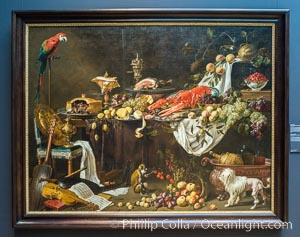
Banquet Still Life, Adriaen van Utrecht, 1644, canvas, h 185cm x w 242.5cm.
Location: Rijksmuseum, Amsterdam, Holland, Netherlands
Image ID: 29466
Location: Rijksmuseum, Amsterdam, Holland, Netherlands
Image ID: 29466

Lot and his Daughters, Hendrick Goltzius, 1616, canvas, h 140cm x w 204cm.
Location: Rijksmuseum, Amsterdam, Holland, Netherlands
Image ID: 29467
Location: Rijksmuseum, Amsterdam, Holland, Netherlands
Image ID: 29467

